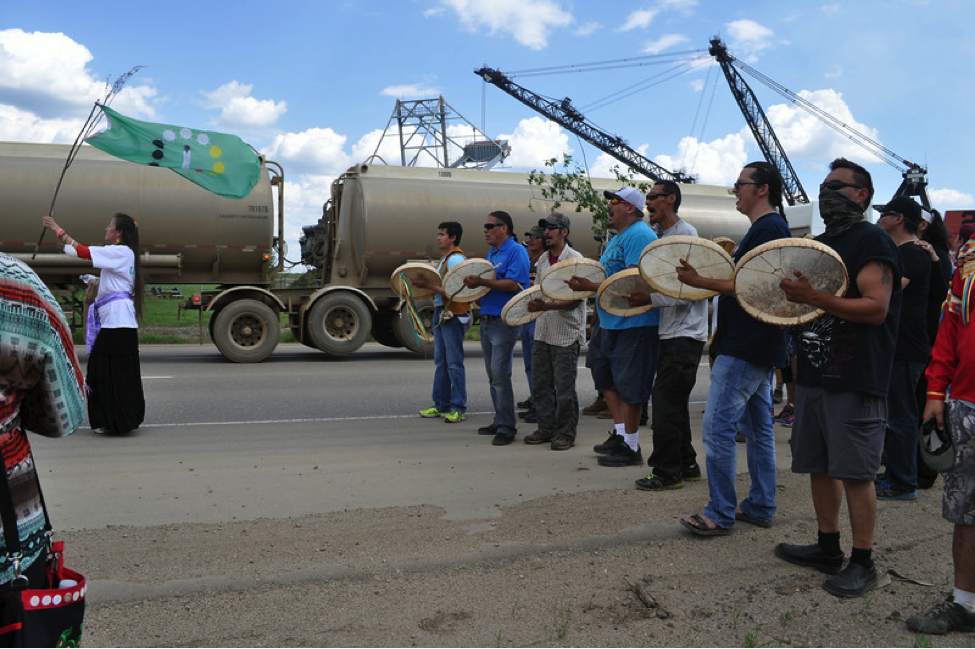In late June, a team of RAN staff travelled to Fort McMurray in Alberta, Canada to participate in the Tar Sands Healing Walk, which is organized and hosted by members of the local First Nations Communities. Walking amidst the tar sands destruction was a humbling and powerful experience.
This blog post is one of a series, sharing our impressions and reflections.
Todd’s previous post was “Industry’s Dreams, Indigenous Nightmares: A Visit to the Alberta Tar Sands”.
We left the tar sands boomtown of Fort McMurray via Highway 63, a notoriously dangerous road we were warned was trafficked by huge trucks hauling mining machinery and by oil workers cutting loose on their time off. Fortunately, we traveled the short distance to the Tar Sands Healing Walk camp without incident. We joined the healing walk encampment, a collection of tents and teepees along the beautiful Gregoire Lake, and were hosted by Keepers of the Athabasca, a network of Indigenous First Nations groups.
The natural beauty of Alberta is striking, and deceptive. At first glance, the land looks unspoiled, with thick stands of white-barked birch, a big sky, and the placid waters of Gregoire Lake. Tragically, the idyllic façade belies profound contamination: the air, waters, animals, and people of Alberta are poisoned. This reality was quickly hammered home in the Tars Sands Healing Walk camp. Drinking water for the gathering of several hundred had been pumped from a residence at nearby Fort Chipewyan, and the water reeked of methane gas. Apparently, some of the well-intentioned visitors in attendance helpfully pointed this out to the community hosts, prompting a sobering announcement from the stage: “People are complaining about the water smelling of methane. This is what people drink here. There is no other water.” Later the same day, Annette Campre from Fort McKay First Nation told the crowd that she has been using bottled water to bathe her children for years. The Athabasca River flows north through the tar sands mines, carrying contaminants away from major population centers and toward Fort Chipewyan, a community of Chipewyan, Cree, and Metis First Nations people. One suspects that the intense water contamination visited on Fort Chipewyan would not be permitted if the river of pollutants flowed south from the tar sands into the Canadian cities of Edmonton and Calgary.
The consequences of tar sands mining contaminants are disproportionately borne by First Nations communities, like Fort Chipewyan, a tiny town with a hugely anomalous incidence of rare and aggressive cancers, like bile-duct cancer. At the Tar Sands Healing Walk encampment, we heard from Dr. John O’Connor, the fly-in doctor for Fort Chipewyan and early whistleblower on the abnormally high incidence of cancers in the region. Dr. O’Connor recounted efforts by industry and government to discredit his first-hand observances, which have been borne out in a recent study that found that 21.3% of surveyed First Nations persons displayed evidence of cancer. The study also reported “that cancer occurrence is significantly and positively associated with participant employment in the Oil Sands as well as the consumption of traditional foods and locally caught fish.”
The cancer epidemic faced by First Nations communities in the Alberta Tar Sands region are appalling, but the damage inflicted by tar sands mining on Canada’s original people goes deeper. The same recent study documented “elevated levels of the environmental contaminants arsenic, cadmium, mercury and selenium, as well as PAHs (some carcinogenic) in the foods traditionally harvested by the First Nations in the region.” Translation: the game that Indigenous people rely on in Alberta is ridden with toxins. For First Nations people, this has much deeper implications than the simple right to uncontaminated food stocks. As I learned at the Tar Sands Healing Walk, many of the important ceremonial and spiritual practices of Alberta’s First Nations rely on traditional relationships with game, including hunting and the consumption of this meat. Tar sands developments threaten local species like the caribou with extinction, and are poisoning fish and game stocks. For First Nations communities, the contamination and degradation of the land is an existential threat; if First Nations people are unable to pass on traditional knowledge and practice, their culture and spiritual practice is destroyed. As we learned at the Tars Sands Healing Walk, the continued development of the Albertan tar sands is a perpetuation of cultural genocide by settler culture.
So what is to be done about this? Tune in next week for a final post—“Resistance: what do we do about the tar sands?”
Image: Chipewyan drummers lead the Tar Sands Healing walk. The Chipewyan culture is directly threatened by tar sands mining.
